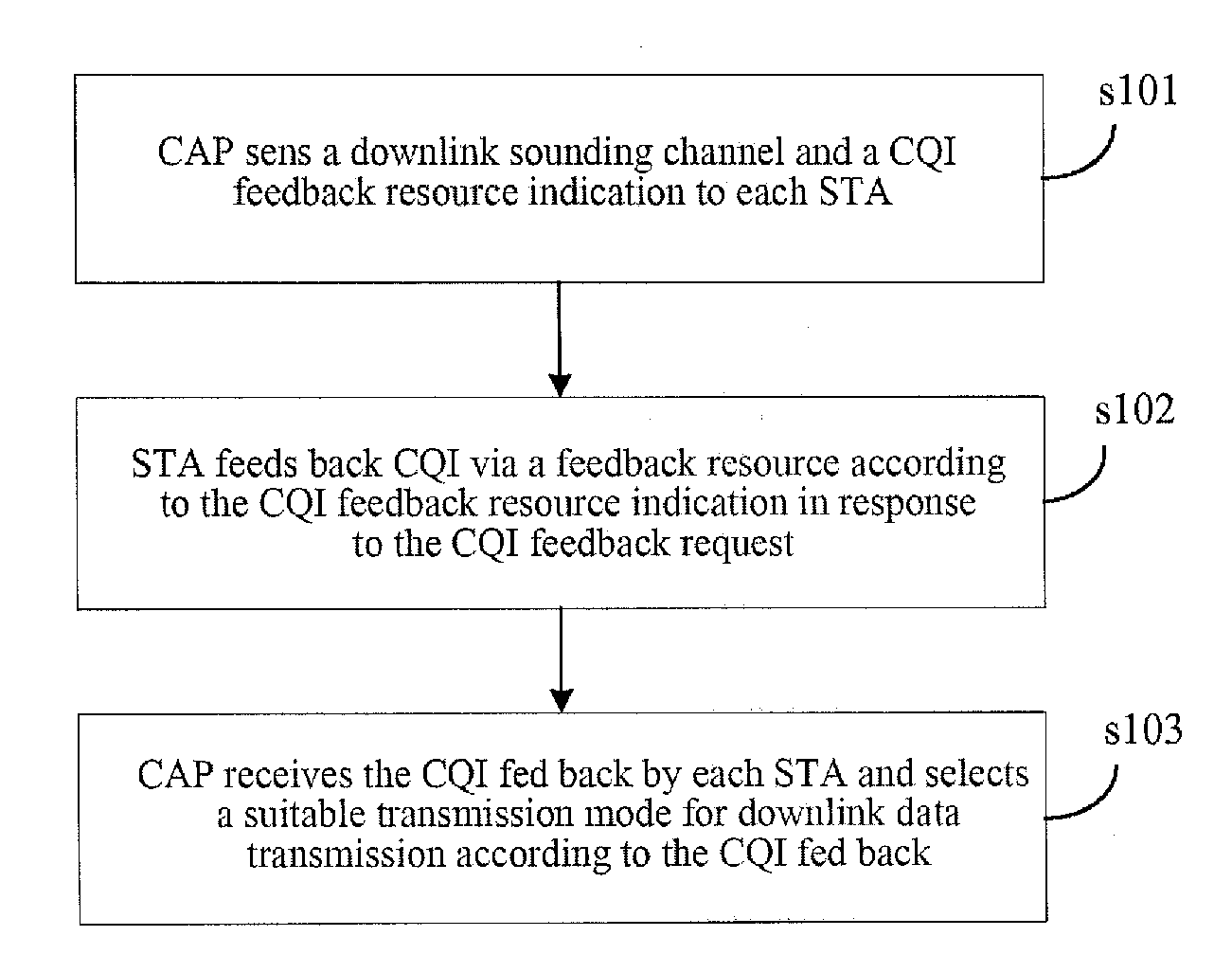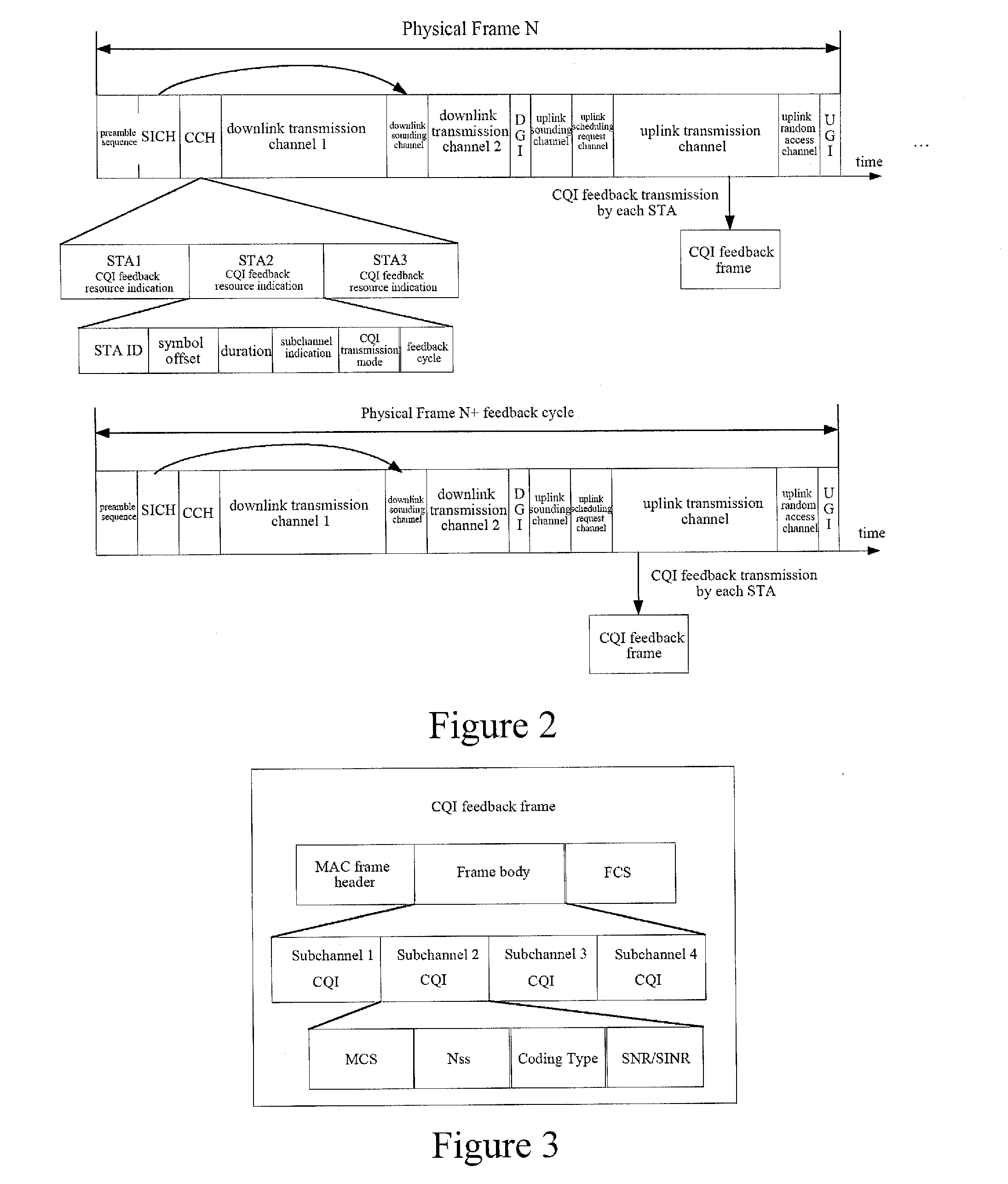Method for Implementing Link Self-Adaptation, Network Device and Terminal Device
a network device and terminal device technology, applied in the field of wireless communication, can solve the problems of severe shortage of spectrum resources and unsuitability for time-varying channels, and achieve the effects of saving system resources, saving signaling overhead, and optimizing resource configuration
- Summary
- Abstract
- Description
- Claims
- Application Information
AI Technical Summary
Benefits of technology
Problems solved by technology
Method used
Image
Examples
first embodiment
A First Embodiment
[0138]Referring to FIG. 1, the first embodiment of the invention provides a method for implementing downlink adaptation, which includes the following steps:
[0139]Step S101: sending, by a CAP, a downlink sounding channel and a CQI feedback resource indication to each STA;
[0140]Step S102: feeding back the CQI via a feedback resource according to the CQI feedback resource indication by the STA in response to a CQI feedback request; and
[0141]Step S103: receiving, by the CAP, the CQI fed back by each STA, and selecting a suitable transmission mode for downlink data transmission according to the CQI fed back.
second embodiment
A Second Embodiment
[0142]Referring to FIG. 1, the second embodiment of the invention provides a method for implementing downlink adaptation, which employs a periodic feedback mechanism and includes the following steps S101-S103:
[0143]Step S101: sending, by a CAP, a downlink sounding channel and a CQI feedback resource indication to each STA.
[0144]Preferably, the downlink sounding channel and the CQI feedback resource indication may be packaged in a physical frame for sending.
[0145]Preferably, the CQI feedback resource indication contains a feedback cycle used for instructing the STA to periodically feed back the CQI.
[0146]The so-called periodic feedback mechanism is such that the CAP periodically allocates, within a control channel at the physical layer, a resource for the uplink channel feedback by the STA, without requiring the CAP to send any CQI feedback request. Thus, preferably, the CAP may make the following preparations before Step S101:
[0147]The CAP configures a downlink so...
third embodiment
A Third Embodiment
[0197]Referring to FIG. 1, a third embodiment of the invention provides a method for implementing downlink adaptation, which employs a request-response feedback mechanism and mainly includes the following steps S101-S103.
[0198]Step S101: sending, by a CAP, a downlink sounding channel and a CQI feedback resource indication to each STA.
[0199]Preferably, before sending the downlink sounding channel and the CQI feedback resource indication, the CAP further sends a CQI feedback request which is used for instructing an STA to feed back the CQI.
[0200]Preferably, after sending the downlink sounding channel and the CQI feedback resource indication, the CAP further sends a CQI feedback request.
[0201]Preferably, the CQI feedback request is sent at the same time when the CAP sends the downlink sounding channel and the CQI feedback resource indication.
[0202]Preferably, the downlink sounding channel, the CQI feedback request and the CQI feedback resource indication may be packag...
PUM
 Login to View More
Login to View More Abstract
Description
Claims
Application Information
 Login to View More
Login to View More - R&D
- Intellectual Property
- Life Sciences
- Materials
- Tech Scout
- Unparalleled Data Quality
- Higher Quality Content
- 60% Fewer Hallucinations
Browse by: Latest US Patents, China's latest patents, Technical Efficacy Thesaurus, Application Domain, Technology Topic, Popular Technical Reports.
© 2025 PatSnap. All rights reserved.Legal|Privacy policy|Modern Slavery Act Transparency Statement|Sitemap|About US| Contact US: help@patsnap.com



